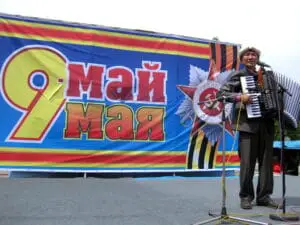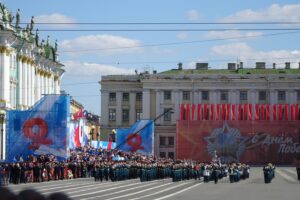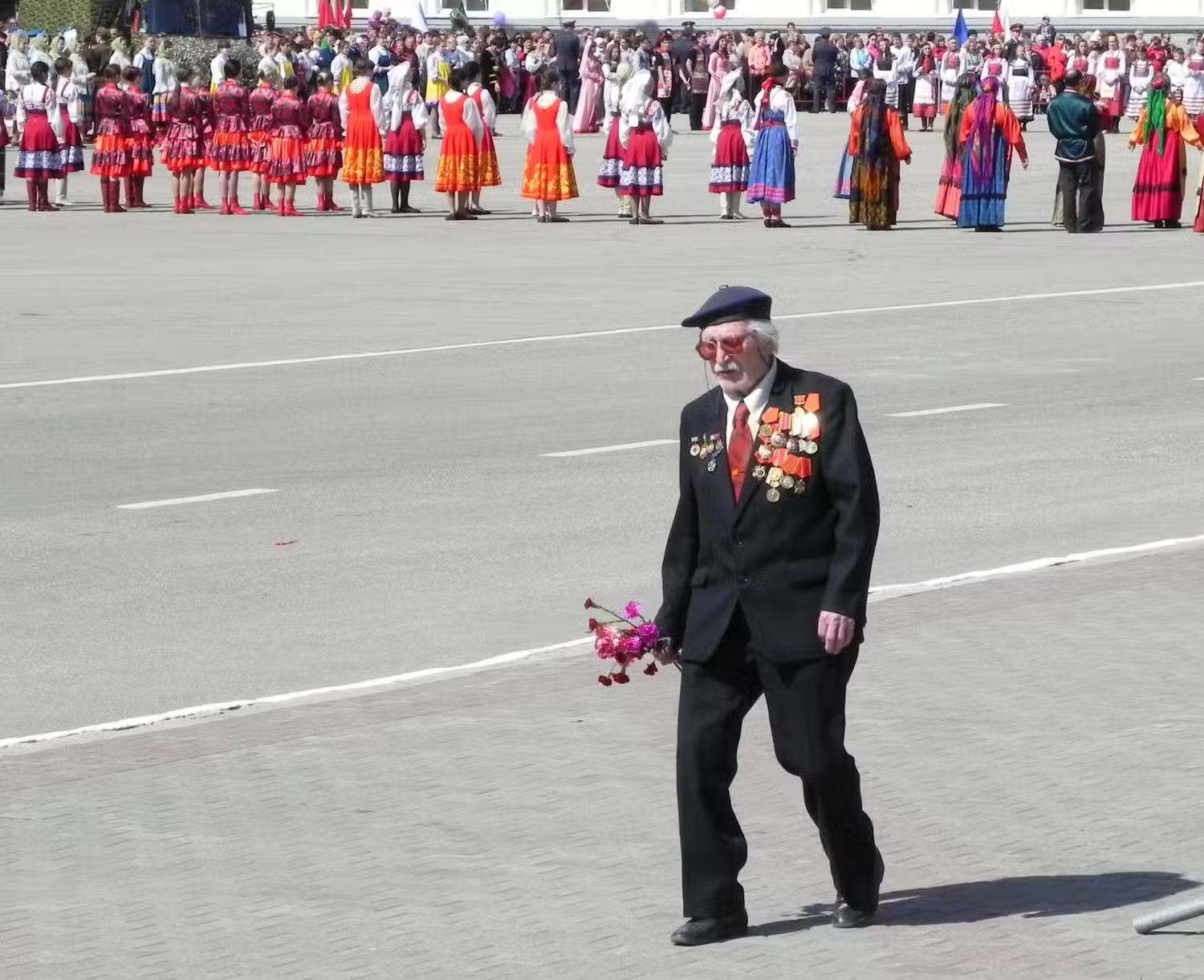Victory Day is a holiday of significance in many Eurasian cultures, but particularly stands out in Russia. People pay homage to veterans and remember the sacrifices that were made for the sake of victory in WWII.
While Victory Day is deeply ingrained in Russia’s national identity, its observance across Eurasia reveals nuanced changes or adaptations reflective of each nation’s historical narrative. The following resource provides an introduction to these issues with historical background and vocabulary that will of interest particularly to students of Russian.
Introduction to Victory Day and its History
День Победы (Victory Day) is праздник победы советского народа над фашизмом (a celebration of the victory of the Soviet people over fascism). It is one of the most important holidays in Russia and чествует ветеранов (honors veterans) of Великая Отечественная Война (The Great Patriotic War), which is what Russians call WWII.
 День Победы в Европе (Victory Day in Europe; where it is often known as V-E Day) is празднуется (celebrated) on May 8 or 7th. This date marks the surrender at Reims on May 7 (or its delivery and announcement on May 8th), which ended the war in Western Europe.
День Победы в Европе (Victory Day in Europe; where it is often known as V-E Day) is празднуется (celebrated) on May 8 or 7th. This date marks the surrender at Reims on May 7 (or its delivery and announcement on May 8th), which ended the war in Western Europe.
День Победы в России (Victory Day in Russia) is celebrated on May 9th. Stalin had a separate капитуляция подписана (surrender signed) by the Nazis specifically to the Soviets on May 9. Stalin justified this saying that since the Soviets contributed the most support to разгром нацистов (defeating the Nazis), that the surrender should be to the Soviet forces and furthermore should be signed in Berlin as that was центр нацисткой агрессии (the center of Nazi aggression). The Soviets had captured Berlin in a celebrated victory shortly before the Nazis surrendered.
America doesn’t really have a major holiday that directly corresponds to Victory Day. Memorial day is also celebrated in May (on the last Monday of that month), but Memorial Day чествует погибших солдат всех войн (honors all fallen soldiers for all wars) and was originally started to honor those dead from Гражданская Война в США (the American Civil War), which was самая кровопролитная война (the bloodiest war) ever fought on American soil.
WWII was the bloodiest war ever fought на российской земле (on Russian soil). Russia потеряла больше людей, чем любая другая страна (lost more people than any other country) – some 21-28 million soldiers and civilians.
Одна из самых сильных сторон (one of the biggest strengths) of the Soviet army was its seemingly endless снабжение людскими ресурсами (supply of manpower). Other nations had более развитые военные технологии (more advanced war technologies) in terms of современное вооружение (advanced weaponry) and тактика боя (battle tactics). However, the Soviet Army didn’t ever seem to run out of soldiers to resist the advancing enemy armies it faced.
Советская Армия (the Soviet Army) fought Nazi Germany on the Восточный фронт (Eastern Front), while other European countries and the US fought in the West. Both fronts were horrific in the violence they saw and it is likely that one would not have prevailed without the efforts of the other. Unfortunately, in most Soviet and Russian school history textbooks, the role of the Western allies is diminished; likewise, in most western school history textbooks, роль Советов уменьшилась (the role of the Soviets is diminished).
The efforts of both sides were crucial. The supplies of military equipment from the USA, for instance, greatly contributed to the success of the Soviet Army in the critical periods such as битва под Москвой (Battle of Moscow) in 1941. Likewise, had not the Soviets tirelessly worn down the Nazi army with incredibly bloody battles such as Сталинградская битва (The Battle of Stalingrad), it’s likely that the Nazis could have conquered and held Western Europe.
May 9th Celebrations Across Eurasia
May 9 is celebrated in Russia as well as many other countries that were once часть СССР или коммунистического блока (part of the USSR or the Communist Bloc). However, while Russia celebrates May 9th почти так же, как СССР (nearly exactly as the USSR did), most other countries have altered the name and celebration.
Ukraine, for instance, has changed the name to an incredibly long “Day of Remembrance and Victory over Nazism in World War II 1939 – 1945” (in Ukrainian: День пам’яті та перемоги над нацизмом у Другій світові́й війні 1939 – 1945 років) and moved the date to May 8th. All of this aligns Ukraine with Europe – including the date of the holiday, the name of the war (no longer referring to it as The Great Patriotic War), and recognizing the war as beginning in 1939. Russia dates the Great Patriotic War from 1941, the year Hitler invaded the USSR.
In the Caucasus, Armenia celebrates both May 8th and 9th. May 8th honors a military regiment that was instrumental in taking the great cultural center of Sushi in 1992 in the First Nagorno-Karabakh War, fought with Azerbaijan. May 9th was renamed “Victory and Peace Day” (in Armenian: Հաղթանակի և Խաղաղության տոն) and long celebrated firstly the liberation of Shushi, and the anniversary of the establishment of the Artsakh Defense Army and secondly the victory over Nazi Germany in WWII.
Neighboring Azerbaijan has now named May 9th “Victory over Fascism Day” (in Azerbiajani: Faşizm üzərinə qələbə günü) to differentiate it from a newer holiday that now overshadows it. Azerbaijan’s new “Victory Day” (Zəfər Günü), marked on November 8th, celebrates its victory over Armenia in the Second Nagorno-Karabakh War in 2020.

In Central Asia, the holiday is also still celebrated. In Kyrgyzstan, for instance, is still known as “Victory Day” (in Kyrgyz: Жеңиш күнү). Meanwhile in Uzbekistan, it is known as a “Day of Remembrance and Appreciation” (in Uzbek: Xotira va Qadirlash Kuni).
In all Central Asian countries, May 9th is marked with large-scale events to honor veterans and to remind each other of the great sacrifices made by the populations of their countries in contributing the victory over the Nazis. All five Central Asian presidents have regularly attended the military parade held in Moscow and all did so in 2024. However, no Central Asian or Caucasian country has held its own full-scale military parade for Victory Day in several years. In some, many events are concentrated in the country’s capital while the regions have much more modest events. Most cite the cost of the celebrations as the reason to scale them back.
Some commentators, including Russia’s Foreign Ministry, have speculated that this scaling back of celebrations is a sign that these countries still honor but no longer prioritize Victory Day and WWII as major parts of their national identities. Indeed, in many places, it seems that this may be the case.
How Victory Day is Celebrated in Russia
In Russia, events are held in nearly every city, town, and village. Many Russians participate in these official events and many more take advantage of the long holiday to gather with family and friends, often at dachas outside of town.
Official events usually include парады военнослужащих (parades of servicemen) where ветераны приглашаются (veterans are invited). Those that are still alive often come and are immediately recognizable by their military medals pinned to their jackets. In earlier years, veterans participated in parades. However, currently most of the veterans are about 90 years old or older, and so they just sit and watch parades.
Самый известный (the most famous) parade происходит (occurs) in Moscow on Red Square, but cities all over the country have their own parades also. There are концерты и представления (concerts and performances); церемонии (processions) such as возложение цветов (laying flowers) at могила неизвестного солдата (the grave of the unknown soldier) in Moscow and at war memorials throughout the country.
In Moscow, there is a tradition that on May 9 veterans gather in front of the Bolshoi Theater. This started as a way to hold a sort of reunion, but it is now also a tradition that many younger Russians participate in, arriving to the area to greet the veterans come, give them flowers and благодарить (thank) them for their service.

In recent years, especially as veterans have become sparse, a citizen-led Бессмертный полк (“Immortal Regiment”) movement has risen. This is a new, separate parade, usually held after the main military parade, in which люди несут большие фотографии (people carry large pictures) of their relatives who participated in WWII and have since passed on. This movement has found its way to many cities across the globe where large numbers of Russians reside.
In recent years, even Russia’s Victory Day celebrations have been disrupted. Covid caused the first of these disruptions – the 2020 parade was postponed to July as Russia was still in lockdown in May. The 2023 parade on Red Square was heavily scaled back due to security precautions connected to the war in Ukraine. In 2024, many Russian regions near Ukraine that have seen Ukrainian drone or missile attacks, have cancelled celebrations for security concerns. The main Red Square events, however, were as large as ever in 2024 and attended by many high ranking politicians and ambassadors from Eurasia.
For more about how Victory Day was celebrated under covid, see our Quarentine Diary entries from the Immortal Regiment Online and Victory Celebrations Online.
For more about how Victory Day was celebrated in Russia and Kyrgyzstan in 2016-2019, see this page of collected student observations.
The Ribbon of Saint George – Russia’s Main Symbol of Victory Day
The main symbol of May 9th as long been the Георгиевская лента (The Ribbon of Saint George). The ribbon colors and pattern were part of many high военные награды (military decorations) awarded by Imperial Russia and the Soviet Union and still part of many awards granted by the current Russian Federation. These awards include Орден Святого Георгия (Order of Saint George) and the Soviet Орден Славы (Order of Glory). The ribbons have been displayed on May 9th as знак памяти и уважения к подвигу солдат в годы Великой Отечественной Войны (a sign of remembrance and respect to the heroic deeds of soldiers in the years of the Great Patriotic War).

The ribbons gained much wider popularity after 2006 when they раздавались (were distributed) in Moscow via an initiative of RIA-Novosti (a state-run news agency) and Студенческая община (The Student Society; a state-supported NGO). Today, they are available almost everywhere, including many grocery checkout lanes where they are given out for free to shoppers. The ribbons are often worn on jacket lapels, tied to backpacks, or to some part of an automobile (the radio antenna, rearview mirror, or door handle being most common). The ribbons were initially controversial as many, particularly older Russians, considered handing out the ribbon to everyone a degradation of the honor the ribbon is supposed to signify in state awards. Some particularly complained about it being tied to cars where it often became dirty and ratty. However, since Russia’s takeover of Crimea, the ribbons have become an accepted and generally unquestioned display of patriotism in Russia
In recent years, some Russians have started wearing the black and orange stripped ribbons year-round as a general sign of patriotism.
More on Holidays
Find all resources about Victory Day and its celebration across Eurasia on our site here.

In Memory of the Warsaw Uprising
Walking around Warsaw on a daily basis, I have not become a stranger to witnessing memorials or places where something important in history has occurred. Everywhere in Warsaw it seems to be a reminder of the dark past. The oppression started on September 1st, 1939 when the German Nazis invaded Poland. The population was separated […]

Polish Independence Day: Student Observations
Independence Day is celebrated in Poland on November 11th. Polish Independence Day commemorates the re-establishment of the state of Poland at the end of World War I in 1918. The holiday was abolished by the communists, but was instituted in 1989, after the fall of communism. Celebrations across the country include firework displays, concerts, and […]

Victory Day in Russia and Other Countries: Vocabulary and History
Victory Day is a holiday of significance in many Eurasian cultures, but particularly stands out in Russia. People pay homage to veterans and remember the sacrifices that were made for the sake of victory in WWII. While Victory Day is deeply ingrained in Russia’s national identity, its observance across Eurasia reveals nuanced changes or adaptations […]

Labor Day: Student Observations
Labor Day is celebrated in many countries of Eurasia every May 1st. Formerly International Worker’s Solidarity Day under the old Communist system, it seems that everyone calls this one something different now. “Labor Day,” “Worker’s Day,” and “Day of Spring and Labor” all seem to be used, often even in the same counrty, but everyone […]

Russia Day: Student Observations
Russia Day is celebrated on June 12th. This holiday commemorates the adoption of the 1991 Declaration of Sovereignty of the Russian Federation which declared Russia’s independence from the USSR. However, many Russians are still unaware that this was ever done – and view Russia, instead, as a successor state to the USSR. In accordance with […]




